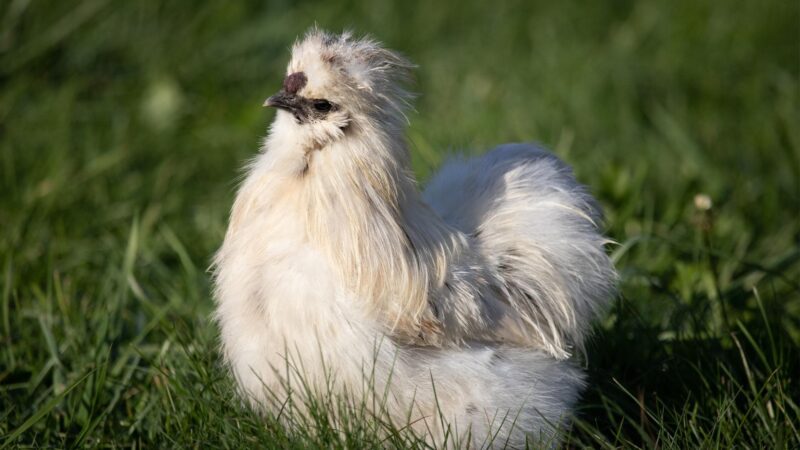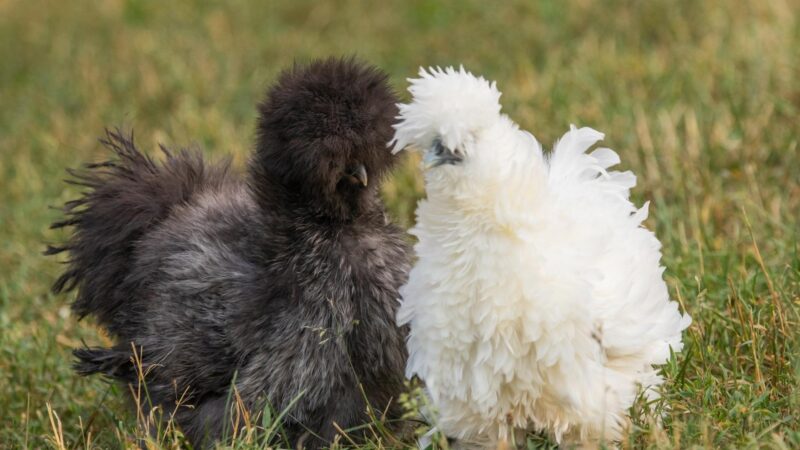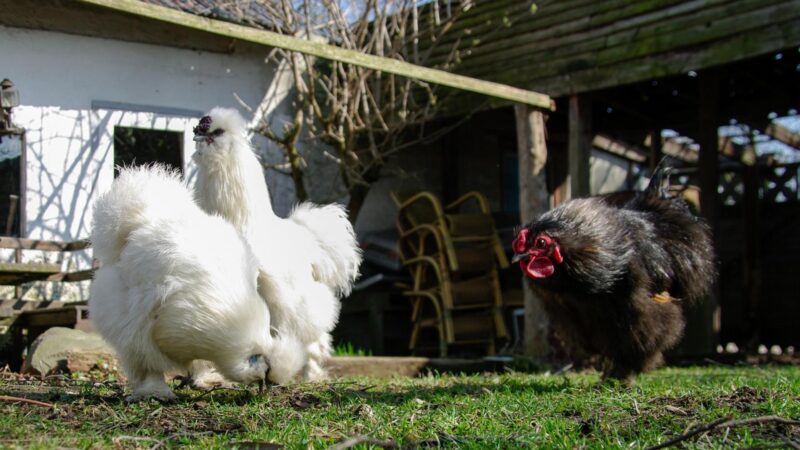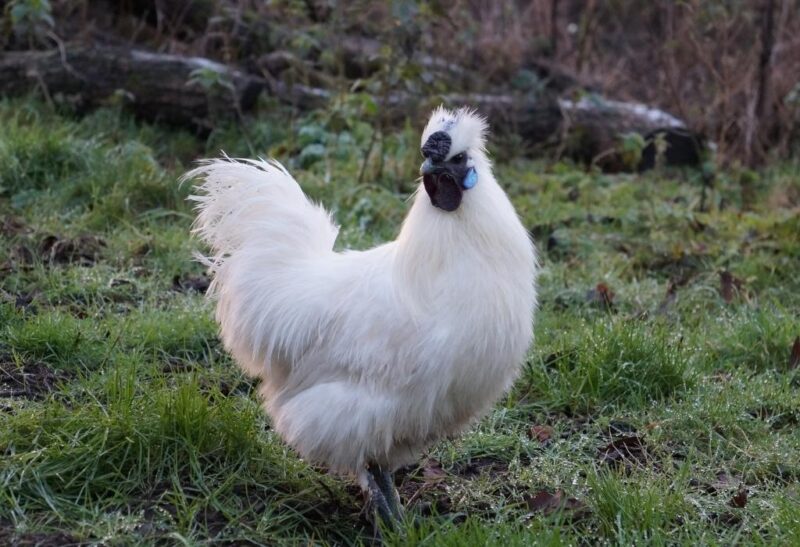Known for their silk-like feathers and plump bodies, these chickens look like adorable walking pom-poms. Unlike regular chickens, silkie roosters and hens have similar features that make them hard to distinguish. So in this article, you’ll learn how to identify a silkie rooster, as well as its characteristics and other similar information.
The silkie rooster is the male species of the silkie chicken breed. At first glance, it can be distinguished from the hens because of its noticeably larger size, larger wattle, and walnut-shaped comb. It also has a squarish crown, as opposed to the hen’s roundish crown.
But aside from these features, there’s much more to learn about these unique-looking birds. If you want to learn more about silkie roosters, continue reading.
Table of Contents
What Do Silkie Roosters Look Like?

At first glance, what you’ll instantly notice about the silkie rooster is that it looks like a walking pom-pom. It has feathers that look a lot like long fur, which allows it to easily stand out from the flock. This is true regardless of its color – whether it’s white, black, buff, or any of the other silkie colors.
The silkie rooster also has crest feathers that look less uniform than its hen counterpart. As a result, these feathers often go in different directions, giving the rooster a more squarish appearance. Some silkie roosters have crest feathers long enough, which end up covering their eyes – much like bangs on humans.
Another notable feature of the silkie rooster is its earlobe color. Other breeds have pale blue earlobes, while the silkie’s earlobe is a vivid turquoise.
Additionally, the silkie rooster has a dark blue to purplish wattle and comb. This is another glaring difference, as opposed to the regular rooster’s red or pinkish wattle and comb.
The black beak on the silkie rooster is another glaring difference. Most chicken breeds have yellow to white-colored beaks, so a black beak is unique. Interestingly, underneath all that feather is also black skin, which is why silkie chickens are considered an exotic breed.
And that’s not all. If you look closely at the silkie rooster’s feet, you’ll notice that there are five toes. In contrast, most chicken breeds only have four toes.
How to Tell the Difference Between Silkie Hen and Rooster?

Both the silkie hen and the rooster have silk-like feathers, dark-colored combs and wattles, black beaks, and five toes. This can lead to a lot of confusion, especially to the untrained eye. But if you look closely, you’ll notice that there are noticeable differences between the hen and the rooster.
For reference, here is a table to help you differentiate between them:
Silkie Rooster | Identification and Characteristics
| Silkie Rooster | Silkie Hen | |
| Height | Up to 14 inches | 8 to 14 inches |
| Weight | Up to 4 pounds | Up to 3 pounds |
| Crest | Squarish, long streamer feathers | Rounded, short length |
| Wattle | Larger, grows fast | Small to almost none, does not grow as fast as a rooster’s |
| Comb | Larger, walnut-shaped | Smaller, v-shaped |
| Behavior | Bossy, protective | Calm |
Size
The silkie rooster is bigger than the hen, but it is still noticeably smaller than the regular rooster. A silkie rooster stands at around 8 to 14 inches tall and weighs up to 3 pounds only. Despite the fluffy appearance, this bird is still quite compact underneath.
Feathers/Plumage
As previously established, one of the most unique features of the silkie is its silk-like feathers. This results in plumage that’s soft and fluffy – much like a rabbit’s. The reason behind this feature lies in how the feathers are formed.
Unlike regular feathers, a silkie rooster’s feather does not have barbicels. The barbicels are the tiny hooks on each feather branch that keep all the tiny feather branches in place. That’s how feathers maintain their unique shape. Because a silkie feather does not have these tiny hooks, it doesn’t maintain a certain shape – giving it a more fur-like appearance.
Combs and Wattles
The combs and wattles on a silkie rooster are dark blue to dark purple, which contrasts with the red or dark pink ones on a regular rooster. Both silkie rooster and hen have combs and wattles, but the sizes and shapes are quite different.
The comb on a silkie rooster is easily visible due to its larger size. It also looks like a walnut on top of the rooster’s head, making it easily identifiable as opposed to the hen. In contrast, the silkie hen’s comb is much smaller and has a more v-shaped appearance on top of its head.
As for the wattle, the one on a silkie rooster is noticeably larger. It also grows faster on the rooster, so if you see a young silkie growing a wattle, it’s most likely a rooster. On the other hand, the silkie hen’s wattle grows at a much slower pace, so it’s much smaller than the rooster’s. In some cases, you may not see a wattle at all due to its small size.
Crowing
Like other roosters, the silkie breed also crows. Silkie roosters can start crowing between 3 and 5 months, but there are also instances of them only starting to crow at a year old. Nevertheless, there’s no denying that silkie roosters can crow.
What’s worth noting, however, is that silkie roosters are not as loud as regular roosters. It is also observed that they do not crow as frequently as regular roosters – although there are rare silkies that are quite vocal.
Behavior
In general, silkie chickens are known for being friendly and docile. But between the silkie rooster and the hen, it is observed that the males show a more bossy behavior than the hens.
Silkie roosters also tend to be protective of their flock and will show aggression when threatened. But even then, this bird is still quite friendly with other birds and humans.
Personality
Silkie roosters make great pets because of their calm and friendly temperament. They’re also quite sociable. Even when they’re held by humans, they do not show aggression or stress. That’s why they’re recommended as the perfect chicken breed if you have kids.
Five Toes
Another interesting feature that silkie roosters have is their five toes – as opposed to the four toes on a regular chicken. This phenomenon is called polydactyly and is believed to have occurred as a mutation within some bird species throughout the years.
While some other birds also have five toes, it’s undeniable that it’s quite an unusual trait. That’s another feature that makes the silkie rooster stand out from other breeds.
Crest Feathers
The crest feathers on a silkie are another noticeable feature. While there are several bird breeds with interesting crest plumage, silkie crest feathers look like uneven fur on their heads.
Otherwise known as streamer feathers, the crest of a silkie looks more squarish with less uniform lengths. This is in contrast to the silkie hen’s more uniform and roundish crest.
Should You Add a Silkie Rooster to Your Flock?

Silkie roosters are friendly and sociable. They get along well with other chickens and humans, which is why there’s no problem with mixing them up with other chickens. While they’re quite protective, this rooster is still considered non-aggressive.
However, it is because of this docile temperament that they tend to get bullied. Their smaller size is not of help when they’re being attacked, either.
So, if you’re interested in adding a silkie to your flock, make sure that it is mixed with birds with similarly calm personas. This is to ensure the safety of your silkie rooster.
Are Silkie Chickens Good for Meat?
Silkie chickens are good for meat. While dressed silkie meat is smaller than regular chicken, you can still get enough meat for it. It is often roasted or cooked in a soup.
Does Silkie Chicken Taste Different?
Silkie chicken meat tastes almost the same as regular chicken meat. The only difference is that it has a subtle duck flavor to it, but it is barely noticeable if you don’t have a sensitive palate.
Can Silkie Chicken Eggs Be Eaten?
Silkie chicken eggs are safe for human consumption. While silkie eggs are smaller than regular chicken eggs, their eggs are as delicious. These eggs are likewise observed to have bigger and brighter yolks than regular chicken eggs.
How Much Does a Silkie Rooster Sell For?
On average, expect to pay around $15 to $45 on a silkie rooster. Silkies are known for being among the most expensive chicken breeds, with show-worthy roosters selling for up to $55. On the other hand, silkie chicks can sell for around $5 to $15.
Can You Mix Silkies With Other Chickens?
You can mix silkies with other chicken breeds. Silkies are known for being docile and calm, which allows them to live well with other birds. However, it is observed that silkies tend to be bullied by more aggressive chicken breeds, so it’s best to mix them with non-aggressive breeds.
Do Silkie Chickens Fly?
Silkie chickens do not fly. Aside from its unique plumage, this breed is known for its round body and small wings. Because of these features, silkies are unable to fly.
How Long Do Silkies Live For?
Silkies live for an average of 7 to 9 years. This largely depends on how well they are taken care of, with some even living beyond the 9-year mark.
Are Silkie Roosters Friendly?
Silkie roosters are among the most friendly chicken breeds out there. Silkies are especially noted for their calmness and docile temperament.
Silkie roosters and hens may look similar to the untrained eye, but there are quite several differences if you try to look closer. The silkie rooster is visibly larger, has a larger comb, and a more visible walnut, to name a few. There are behavioral differences as well since roosters are more protective than hens. Overall, there’s no denying that the silkie rooster is one of a kind.
List of Sources
Dharmayanthi, A. B., et al. (2017). The origin and evolution of fibromelanosis in domesticated chickens: Genomic comparison of Indonesian Cemani and Chinese Silkie breeds. PLoS One.
Poultry Breeds – Silkie (Bantam) Chicken. (1998). Oklahoma State University.
Zhang, Z., et al. (2016). Parallel Evolution of Polydactyly Traits in Chinese and European Chickens. PLoS One.
He, C., et al. (2017). Genetic pattern and gene localization of polydactyly in Beijing fatty chicken. PLoS One.
Tarrant, K. J., et al. (2020). Assessing MHC-B diversity in Silkie chickens. Poultry Science.
